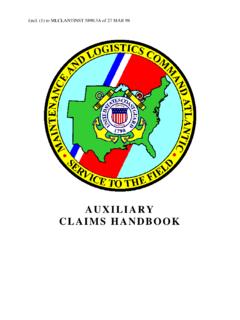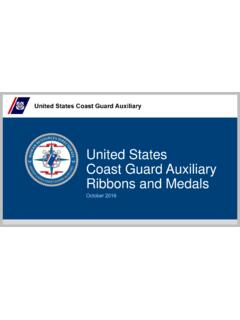Transcription of Auxiliary Telecommunications Qualification Standard
1 United States Coast Guard Auxiliary Department of Operations - Response Telecommunications Division Auxiliary Telecommunications Qualification Standard Auxiliary Telecommunications Operator Specialty US COAST GUARD Auxiliary NATIONAL OPERATIONS DEPARTMENT COMMUNICATIONS Qualification (TCO) USCG Auxiliary Department of Operations - Response TC PQS National 8 Mar 2009 Page 2 of 36 Auxiliary Telecommunications Operator Specialty A. References: (a) Auxiliary Operations Policy Manual, COMDTINST (series) (b) Boat Crew Seamanship Manual, COMDTINST (series); Chapter 11 (c) Auxiliary Aviation Training Manual, COMDTINST (series); Chapter 6 (d) Telecommunications Manual (TCM) COMDTINST (series) (e) Radiotelephone Handbook, COMDTINST (series) (f) Coast Guard Addendum to the United States National Search and Rescue Supplement, COMDTINST (series) (g) Communications Watchstander Qualification Guide, COMDTINST (series) (h) AUXCOM Coast Guard Auxiliary Communications Course (i) Appendices A-G to the Auxiliary Telecommunications PQS (j) Chart , NOAA Nautical Chart Symbols and Abbreviations (k) NOAA or Corps of Engineers charts of the local area.
2 (l) United States Coast Pilot, Vol. 1-9, as applicable to the local area (m) Light List, Vol. 1-7, COMDTINST M16502 (series) , as applicable to the local area (n) NOAA Tide Tables, as applicable to the local area (o) Telephone Directory, as applicable to the local area B. Introduction Radio communications in the US Coast Guard Auxiliary have undergone extensive changes in recent years, and continue to evolve. The advent and use of new technologies, the implementation of Rescue 21, the implementation of GMDSS (Global Maritime Distress and Safety System), and new roles for the Auxiliary post-9/11, have driven many of these changes. In many areas of the country Auxiliary communicators are functioning as Watchstanders from their fixed or mobile Auxiliary stations, either as a regular shift activity or as ad hoc communicators. When functioning in this manner, these Auxiliarists are the voice of the Coast Guard to the boating public.
3 In addition, many stations and operators fulfill key mission requirements when holding guard for Auxiliary and Coast Guard vessels and aircraft. Some specially authorized Auxiliary Radio facilities are also providing direct operational support to CG Communications Area Master Stations (CAMS) and Communications Stations with operations being controlled solely by Auxiliarists. As a result, it is clear that the current comms eligibility based upon completion of the AUXCOM class needs to be updated. Auxiliarists are currently performing tasks USCG Auxiliary Department of Operations - Response TC PQS National 8 Mar 2009 Page 3 of 36 and fulfilling duties for which this program no longer provides adequate training or guidance. The Qualification of Auxiliary communicators must be better linked to actual telecommunication operation with a minimum Standard for such operations.
4 Certification must be based on the successful accomplishment of given tasks, as in other Auxiliary programs. Operators may then be qualified and certified with assurance that they have been trained to Standard . This standardized level of Qualification will allow increased interoperability with Coast Guard units and other agencies and will allow improved response capability during contingency operations. The Qualification detailed in this Standard is not related to the AUXCOM specialty as a part of AUXOP program, but rather is an entirely new Qualification program within the Operations (Response) Department of the Auxiliary . Current comms eligibility based upon completion of the AUXCOM class accomplished prior to the effective date of this Standard will remain in effect indefinitely. Individuals currently comms eligible are encouraged, but not required to meet the Qualification detailed in this Standard .
5 After the effective date of this Standard , completion of the Qualification detailed in this Standard is required for all new communications qualifications. The Qualification detailed in this Standard does not apply to and is not required for operation of those radios which are a part of surface or air facilities when those facilities are in operation under orders. C. Tasking Levels for Communications-Qualified Auxiliarists Auxiliary Telecommunications OPERATOR (TCO) TASKS These tasks are essentially operator tasks, such as basic radio operation and watchstanding at an ACU ( Auxiliary Communications Unit), either fixed or mobile. These tasks would normally be expected of an individual who is primarily responsible for using communications tools as a means to accomplish other operational mission objectives such as maintaining contact with AUX facilities, augmenting CG communications by providing communications through an ACU, or operating an ACU at an AUX or CG event or training exercise.
6 USCG Auxiliary Department of Operations - Response TC PQS National 8 Mar 2009 Page 4 of 36 WATCHSTANDING AT CG FACILITIES Required qualifications for such activities will remain the same as presently in force at individual CG units. Auxiliary OPERATIONAL COMMS (Afloat and Airborne) Use of radio communication aboard operational vessel or aviation facilities will continue to be maintained and operated as part of the Boat Crew or Flight Crew programs and will not require a Telecommunications Qualification . However, if an Operational Facility (OPFAC) is the primary ACU for an event or activity, used solely for communications purposes, radio operators will be required to hold Telecommunications Qualification INSPECTION/VALIDATION of ACU and OPERATORS testing and training will be conducted under the supervision of a Telecommunications (CM) staff officer at any level in the District in which they are being qualified.
7 Trainees shall have 2 years from initiation of their PQS to complete all tasks for certification. If certification is not completed within 24 calendar months, the PQS must be taken and passed again. When operating in more than one district, or transferring to another district, TCOs may be certified by presentation of their previous PQS completion and certification to the District Director of Auxiliary (DIRAUX) via the Telecommunications (CM) chain. USCG Auxiliary Department of Operations - Response TC PQS National 8 Mar 2009 Page 5 of 36 United States Coast Guard Auxiliary Department of Operations (Response) Telecommunications Division Personal Qualification Standards A. Introduction The Auxiliary Telecommunications Qualification Guide is designed to be an integral part of the Qualification process. It contains a collection of tasks that must be learned, practiced, and performed by the candidate.
8 In addition, it contains a set of reading and practical assignments that provide policy and background information for the tasks. 1. Description of Tasks 2. Task designation 3. Task Identification Tasks are identified by designation. For example: ATQ-01-02-TCO a. (ATQ) - Volume designation number Auxiliary Telecommunications Qualification b. (01) - Task Group designation number c. (02) - Task order designation number d. (TCO) - Qualification 4. Task The knowledge or skill objective to be performed. 5. Reference - Information sources used by the trainee and instructor to obtain the background necessary for task performance. 6. Conditions - The environmental and physical circumstances in which the tasks must be performed. Any tools or special equipment needed for the completion of the task are listed here. The conditions listed with each task must be met 7.
9 Standards The specific outcome of the task. Successful task completion is a function of how well a student is able to complete the task without assistance. Generally the task performance standards are as follows. a. Trainees must be able to cite, from memory, specific information and procedures. The trainee must also be able to locate and effectively use all applicable charts and references. Charts must be Standard NOAA or Corps of Engineers charts of the local AORs USCG Auxiliary Department of Operations - Response TC PQS National 8 Mar 2009 Page 6 of 36 where such are available. For inland area AORs, if such charts are not available, then local charts generally in use, such as roadmaps, lake charts or US Geographic Survey terrain maps are acceptable b. Instructors (mentors) may wish to ask questions concerning particular steps for accomplishment in order to evaluate the trainee's total comprehension of the subject matter.
10 C. Trainees must be able to perform all performance tasks without prompting or assistance from the instructor. Each task demonstration must follow the correct sequence with little or no hesitation between the steps for accomplishment. 8. Performance Criteria - These steps delineate the procedure that is best followed for performing each task. They can be utilized two basic ways. Some steps for task accomplishment follow exact procedures that are required for performing a particular operation or using a specific piece of equipment, while others serve as general guidelines for task completion. They provide a performance check-off that can be used by the mentor to determine trainee performance when the trainee performs the task. 9. Accomplished On the Mentor Tracking Form (Appendix G) the designated instructor (mentor) must print his/her name, sign and date this line attesting that the trainee successfully performed the task in accordance with the prescribed standards.








